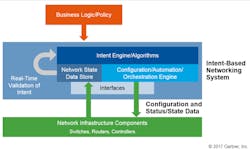Intent-Based Networking (IBN) is not a new concept—it’s actually been around for a few years. Owing to announcements from Cisco this past June, however, it has been heralded as the next big innovation. IBN is a piece of networking software that helps plan, design, implement, and operate networks to improve their availability and agility. And advances in machine learning algorithms are allowing IBN networks to become a reality.
What is an Intent-Based Network?
IBNs work by having the network administrator define a desired state of the network. The automation protocols monitor the network and execute operation improvements until the network is optimized. “BNS is a stark departure from the way enterprise networks are managed today,” explained Gartner Research Vice President Andrew Lerner. “Currently, translation is manual, and algorithmic validation is absent, [but] IBN systems monitor, identify, and react in real time to changing network conditions.”
Gartner lists the four characteristics that define IBNs:
- Translation and validation. IBNs have the ability to translate commands from network administrators into actions for the software to perform. This allows network managers to define the high-level business policy and the IBN ensures that the policy can be executed.
- Automated implementation. Once the state of the network is defined, the IBN software manipulates the network resources to achieve the desired state.
- Awareness of state. IBNs constantly monitor data to ensure the quality of the network.
- Assurance and dynamic optimization/remediation. IBNs maintain the desired state of the network via machine learning. By doing so, the IBN can determine the best way to reach the desired state, then perform automated corrected actions to maintain it.
Lerner said that the current action is to launch IBNs in pilot and proof of concept deployments. The adoption “will be pragmatic, associated with new build-outs and/or network refresh initiatives,” he explained. “Early rollouts will likely be for well-defined and specific use cases, such as a spine/leaf data center fabric or WAN edge infrastructure.” He predicted that by 2020, IBNs could become the mainstream choice for IoT networks.
IBN in the Real World
Two recent case studies from Cisco highlight the benefits of IBNs. Its Digital Network Architecture (DNA) is an early example of IBNs in the real world. DNA is part of Cisco’s Connected Factory portfolio and works on three operating principles:
- Time-sensitive networking. Now supported across Cisco’s IE4000 switch family, time sensitive networking protects the data and ensures the critical applications operate smoothly on the network.
- Connected asset manager for IoT intelligence. The visualization tool can extract data from a variety of sources and combine the data treads across legacy system silos. It also serves as an open and analytic engine agnostic, which makes reporting easy.
- Industrial network director. The DNA system provides full factory control to the operators. It is quick to setup and reduces the risks of downtime. It offers plug-and-play functionality and manages the switches to ensure proper security and settings; no manual programming is required.
The first case study comes from the AW North Carolina (AWNC) company. AWNC is part of the Aisin Group and is the top manufacturer for automatic transmissions and transmission components in the world. Nearly every Toyota Camry (75%), Tacoma (96%), Tundra (85%), and Sequoia (100%) uses a AWNC transmission. The firm supplies Toyota with 600,000 transmissions per year. AWNC deployed Cisco’s network infrastructure, which included a unified communications system, cloud based computing technology, and IBN integration.
Using an IBN resulted in zero downtime. The company was able to implement new enterprise resource planning and manufacturing execution systems to automate and analyze data and processes. They saved more than $1 million in maintenance costs, and AWNC plans to invest further into system automation. It will use the data acquired from the plant floor to increase automation and production efficiency.
The next example comes from ABB, an industry leader in industrial robots and modular manufacturing systems. The company has installed more than 250,000 robots worldwide across several industries, including automotive, plastics, metal fabrication, electronics, machine tools, pharmaceutical, and food and beverage. Along with the installation of these robots, ABB offers continuous monitoring services that include troubleshooting, diagnostics, and maintenance.
ABB achieves this by using Cisco’s Control Center, part of the Jasper platform, to monitor connections to its customers’ industrial robots. By using an IBN, it can manage and automate the connected devices anywhere in the world. The company can anticipate problems by using the IBN, which constantly analyzes information received from the connected devices.
Because one can set the parameters of the network, the IBN will automatically execute change to maintain the desired state. This changed ABB’s model from reacting to customers’ troubleshooting requests to automating responses before incidents can occur. This level of automation provides predictive maintenance, in addition to controlling costs by avoiding unforeseen data consumption. Because the data is real-time rather than an overload of data, ABB can pinpoint the exact robot that requires immediate attention rather than shifting through tons of data.




